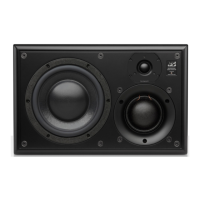The room in which a loudspeaker is placed can be thought of as a filter, altering the acoustic response at the listening position from that of the
loudspeaker. The position of the loudspeaker in a room will influence how it interacts with the space and therefore is often critical to achieving
the best performance at the listening position.
Speaker positioning is important because at low frequencies the room will have a strong influence due to room modes/resonances. Room modes
manifest themselves in an uneven distribution of acoustic energy within the room, which can lead to either too much or too little bass at the listening
position. A room with a well-controlled low frequency response (controlled reverb time) will have a far smaller influence on the performance of
the loudspeaker and will be less sensitive to positioning. Typically, a combination of resonant membrane traps and porous absorbers are needed to
control the low frequency. The resonant membrane traps are effective at treating the low bass, typically below 80Hz and the porous absorbers
frequencies above this. Porous absorbers such as those made from foams, fibreglass or rockwool are not effective at absorbing low bass energy
without a very large air space between them and the wall behind which reduces useable space within a room.
To minimise problems a free-standing loudspeaker should be kept away from corners where possible. Avoid placing the loudspeaker mid-way
between any two parallel walls. Where the loudspeaker is to be installed directly into a heavy, rigid non-absorbent wall (flush/soffit mounted), an
increase in LF efficiency and LF extension should be expected. In-wall loudspeakers are in the optimum position for exiting room modes between
the mounting wall and the opposite wall. The requirement for adequate bass trapping in the rear wall in this instance can be even more critical.
• Typically, best results come from mounting the speakers on suitable speaker stands. Stands should be heavy, rigid, and non-resonant. The stand
height should be selected so that the speaker acoustic centre is at, or just above ear level (see diagram 1).
• If the monitor loudspeakers are mounted above or below ear level, they should be angled down/up so that the mid-range driver is aiming at
the listening position.
• Try to avoid placing speakers on the console/desk meter bridge. This compromises the frequency balance of the loudspeaker, especially in the
upper bass/lower mid-range.
• If speakers are placed on the meter bridge, elevating them away from the desk/console surface can help to reduce the coloration generated by
the reflections.
• Position the loudspeakers so they form an equilateral triangle with the listening position (see diagram 2). With this layout, the distance between
the two mid-range drivers will be equal to the distance from one speaker to the listening position.
• The mid & high frequency drivers of the SCM25A Pro Mk2 are offset. Position the loudspeakers so that these drivers are on the inside. If the
layout of your studio/control room limits the width of loudspeaker spacing then the speakers could be reversed so that the mid and HF drivers
are outboard, resulting in a wider stereo image (for the same cabinet position).
SECTION THREE
Room Interaction
SCM25A Pro M k 2 Monitor Placement
3.1
3.2
Diagram 1 – R1-300 LED and signal wiring
DIAGRAM 1
DIAGRAM 2
Position loudspeaker with acoustic
axis at or up to 5º above ear level
Acoustic axis
distance z
distance x
distance y
Distance x = Distance y = Distance z

